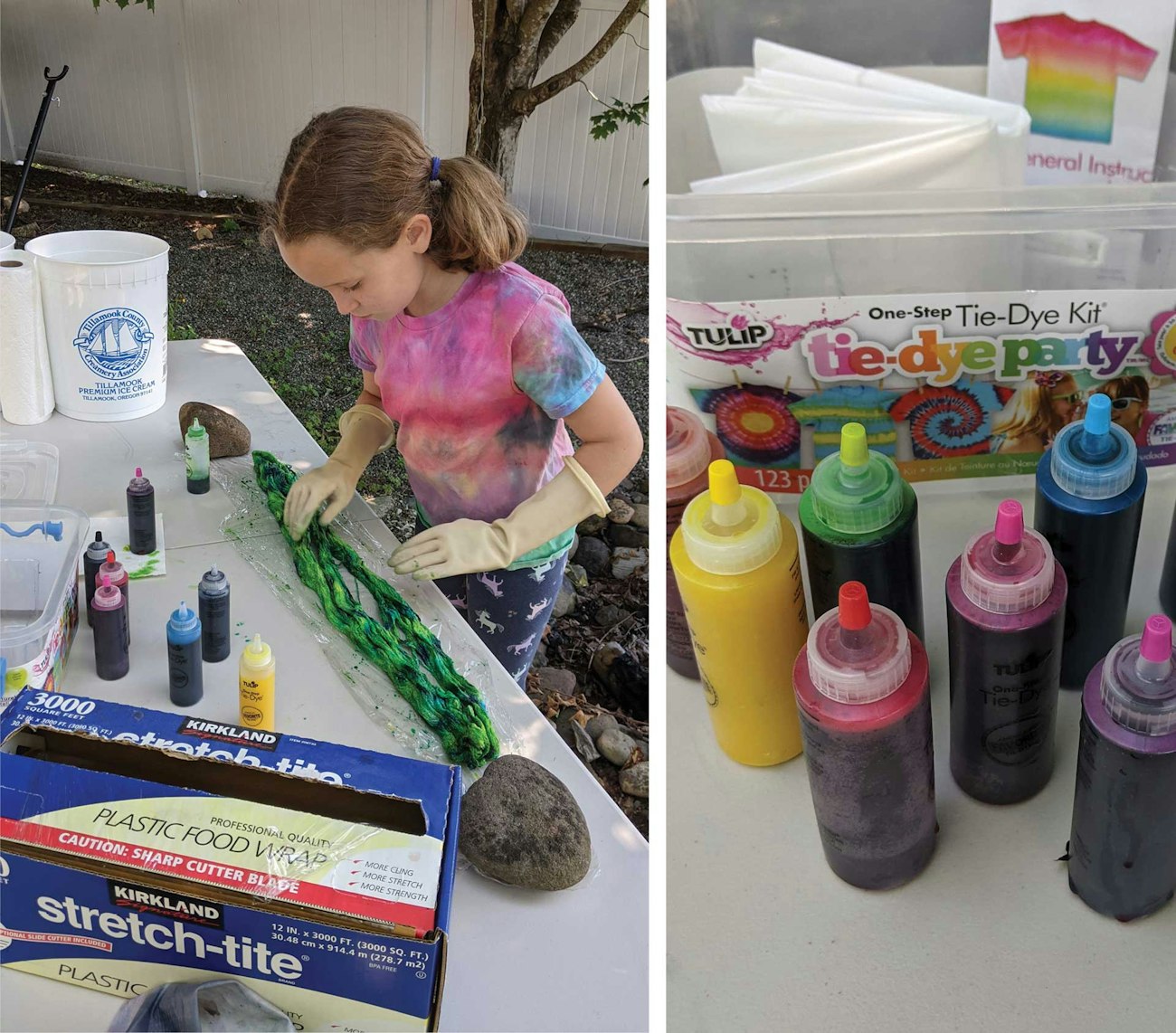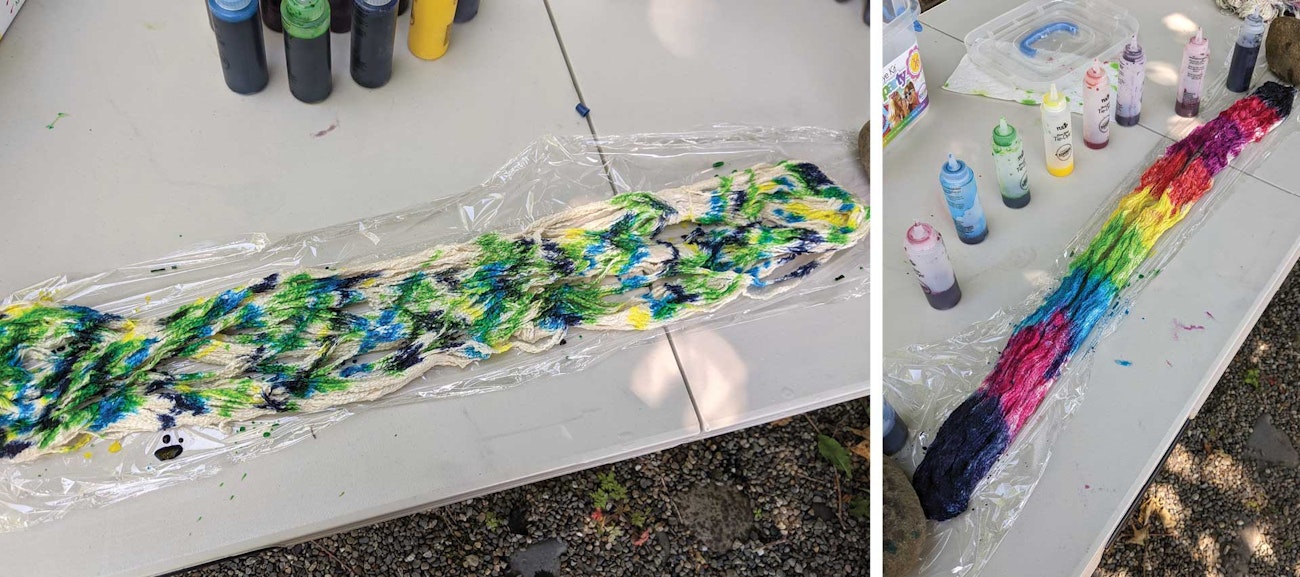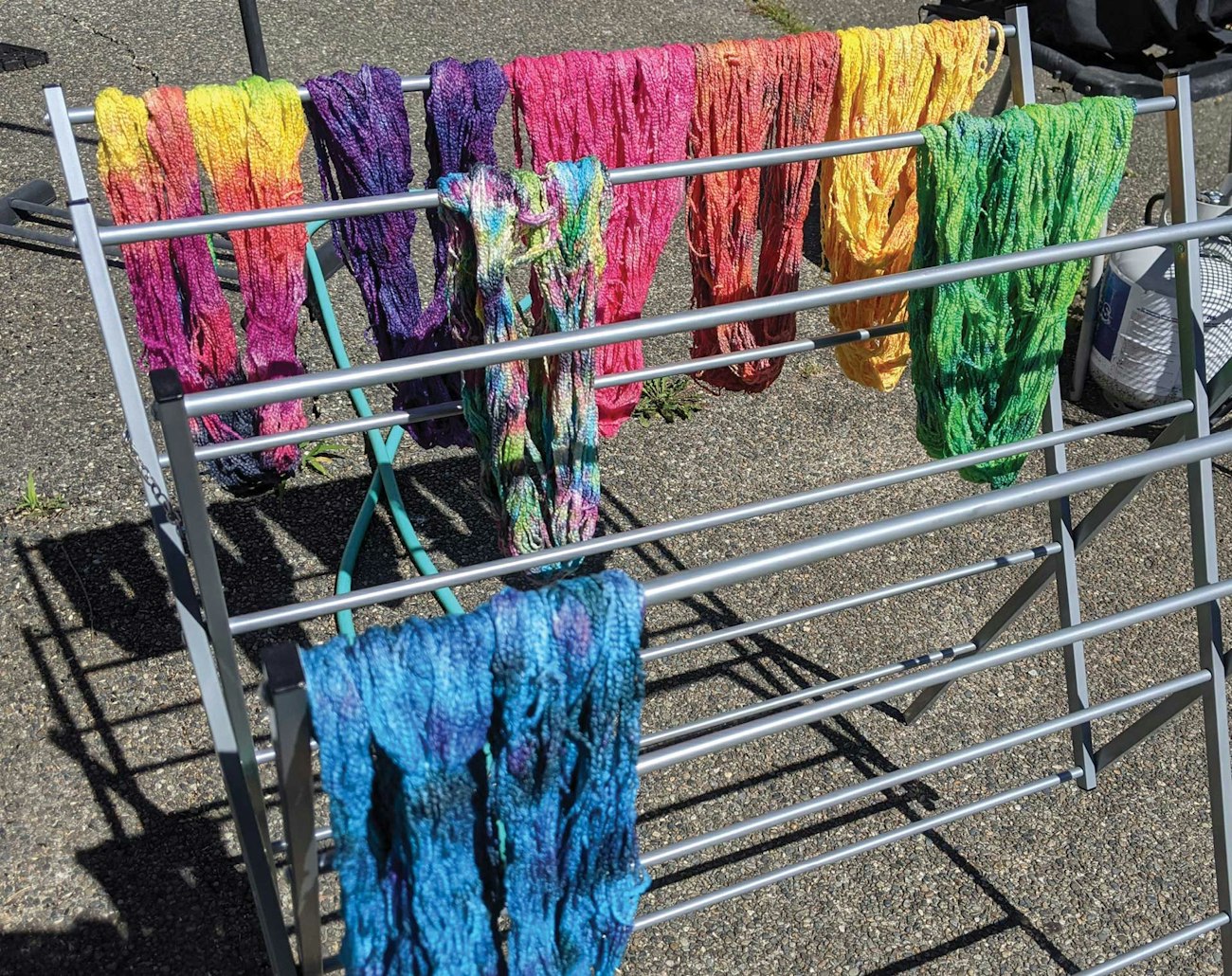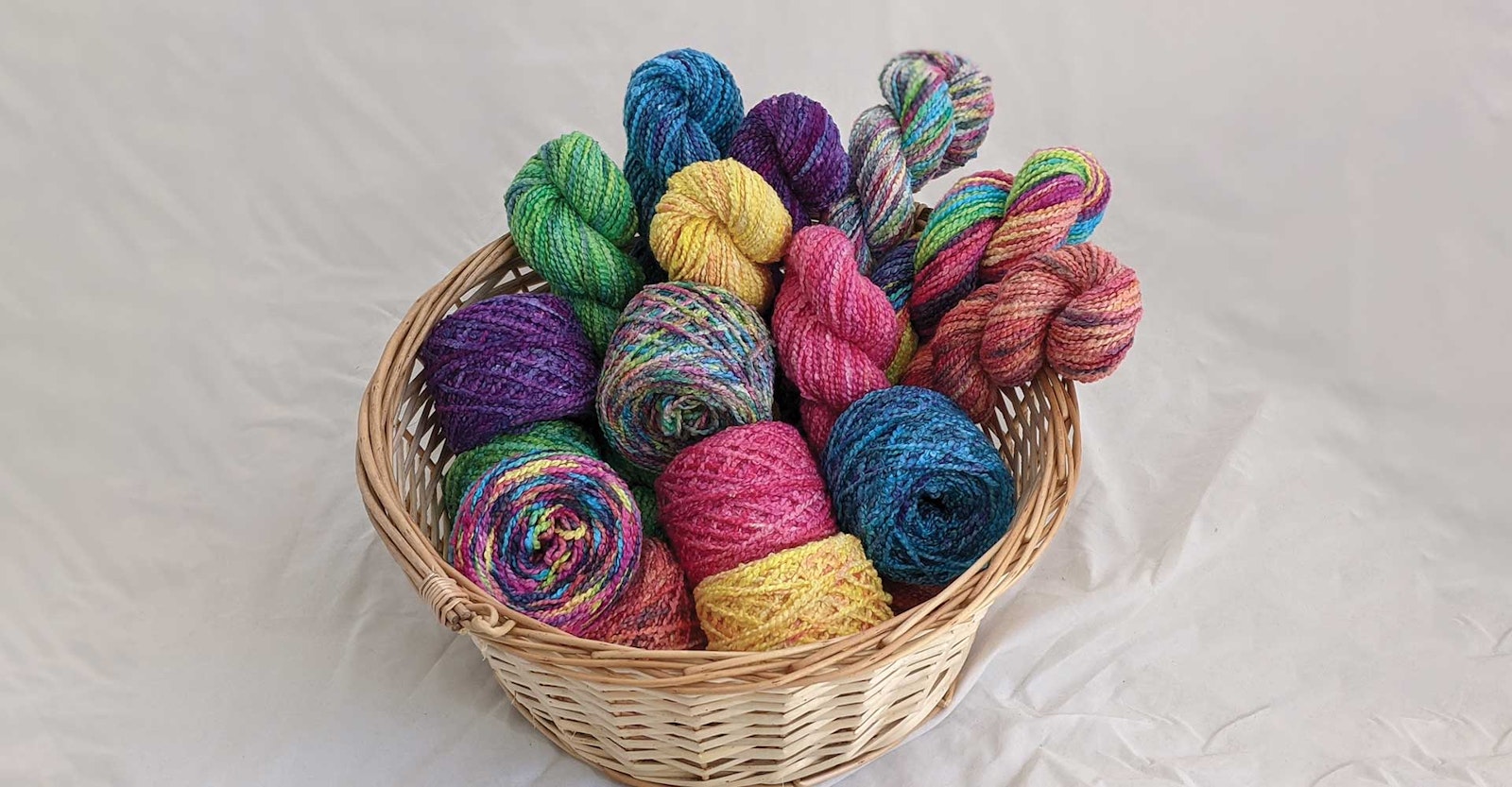Guests & Location
Start by inviting your best color- and fiber-loving friends. Decide on a location that can handle getting wet and messy. Outside is best, although garages also work well. If one of you has a dye studio, all the better! I suggest avoiding kitchens, because food areas or food-preparation tools could become contaminated with dye chemicals. Never use the same tools for dyeing and food.
Materials
- Tie-Dye Party Kit (I prefer Tulip One-Step Tie-Dye Kits)
- Gloves (included with kit)
- Monte Cristo yarn or any cotton/linen/lyocell/plant-based yarn
- Tables with surfaces safe for dyeing, such as plastic, or vinyl or plastic tablecloths
- Buckets big enough to hold the yarn and water—one per person
- Yarn-friendly detergent, such as Synthrapol or Soak (optional)
- Plastic wrap
- Kitchen gloves (optional, but recommended)
- Clothes or aprons that can get dye on them
- Paper towels for cleanup
- Gallon ziplock bags
Dye Area Setup
Set up tables that can get dye on them. I use heavy-duty plastic folding tables that are easy to move around and wash. If you don’t have access to a table that can get dirty, use a plastic or vinyl tablecloth on top of your work surface. Two people to a 6-foot table is ideal, but if you don’t have enough tables for everyone, create a separate crafting circle. People can take turns dyeing and still have somewhere to sit, chat, and be creative when they aren’t dyeing yarn. Make sure to remind your guests to wear clothes suitable for dyeing. Dyes for cotton in particular love getting all over your favorite outfit.
Preparing the Yarn
One of my favorite yarns to dye is Monte Cristo, which I get from Cotton Clouds. It’s 100% cotton with great fluffy texture, making it ideal for hand towels, baby blankets, and scarves. You can see its texture in my photos.
Whatever yarn you choose, before dyeing, make sure it is in a skein or chained warp. The dye needs to soak into the yarn to get good clear colors. The easiest way to skein your yarn is with a skein winder or niddy-noddy. If you don’t have either of those, you can wind yarn around two pegs on a warping board separated by about a yard, use the back of a chair, or wind the yarn around from your hand to your elbow to make a skein. Tie each end of the yarn loosely to the skein. Add additional ties to the yarn to keep it from tangling. There is a balance to the tying: Tie too loosely, and the yarns will tangle. Tie too tightly, and you'll end up with white marks on the yarn, an accidental ikat.
As your guests arrive for the party, have them begin by soaking their yarn in buckets of water. The longer the yarn soaks, the better. If the yarn is particularly dirty, use a few drops of a yarn-friendly detergent such as Synthrapol or Soak. A little hand soap will work in a pinch. Rinse and repeat until the water is clear. Dirt or oils can keep the yarn from taking dye, which will make the yarn look spotted or faded. Even worse, it can look beautifully dyed and then have all the color wash out when it is rinsed!
Mixing the Dye
I recommend using cotton, which is considered tricky to dye and requires mordants or other dye fixers. Well, I have discovered a much easier way that requires only water. I use the handy-dandy tie-dye party kits, such as the ones from Tulip available at craft supply, major retail, or online stores. I had a moment of inspiration when, after my kids’ yearly tie-dye T-shirt party, there was leftover dye, perfect for a couple of small skeins.
Follow the instructions given for mixing the dye. Wait to do this as close to dye time as possible because the dyes lose their potency pretty quickly. Tulip recommends using the dye within 72 hours, but I have found that even after a couple of hours, they can be weaker than when first mixed. The directions say simply to add water to the dye bottles, which already have a premeasured amount of dye in them. I modify this by starting with about 1 tablespoon of water and then shaking the bottle to dissolve the dye. Then I add the rest of the water. If you add the water all at once, sometimes the dye won’t mix, and you end up with little dye flecks on the yarn.

Left: Yarn dyeing parties are fun for all ages. Right: Bottles of dye filled and ready to go
Dyeing the Yarn
On your dye table, lay out a sheet of plastic wrap, about a foot longer than the length of the skeined yarn. Squeeze out any excess water from the yarn. The more water you squeeze out the more dye can go into the yarn. Dye can now be applied with the squeeze bottles. There are two basic ways to dye yarn using direct application: semisolid and variegated dyeing.
Semisolid Dyeing
Technically, you can dye with only one color; however, this uses a lot of dye, and it is difficult to apply a single color evenly. For that reason, I recommend using several colors together in a skein or warp. Start with the color you want to be dominant and sprinkle the dye evenly across the yarn. Then use analogous colors, or colors next to one another on the color wheel, to choose accents. If you start with red, then oranges and yellows will make it more fiery, while purples and blues will make it more wine colored. If you want a speckled yarn, use less dye and keep areas of the yarn white. If you want a more even appearance, keep layering dye, a little at a time, until all the white is gone. Use extra dye around the ties to make sure you won’t have any white lines later on. Squish the yarn with gloved hands to help the colors penetrate the yarn. (The Tulip kit comes with plastic gloves, but if you are going to dye regularly, invest in a pair of sturdy kitchen gloves.) Flip the yarn over and repeat the process. Fan out the yarn and make sure the dye has penetrated all of the strands.
Check out photos online or in books and magazines to find color inspiration. If you like the colors together in a photo, then you will probably like them on your yarn. I recommend staying away from complementary colors, those across the color wheel from each other, such as yellow and purple, because they can make muddy colors. Experientation is key. The more you dye, the more comfortable you will get with what works and what doesn’t.
Variegated Dyeing
For a different look, try variegated dyeing and dye color blocks rather than layering and overlapping colors. The skein or warp can be divided in half or in quarters or even in 1-inch blocks, depending on how big you want each color block to be. I have fun using the last of the dyes to do about an inch of each color randomly. It doesn’t take much dye at all. Just make sure there is enough to do both sides. When you are satisfied with the top side of the yarn, flip it over and repeat the colors on the opposite side. Fan out the yarn and make sure all the strands are covered in the colors you want.

Left: Example of handpainted yarn. Right: Example of variegated dyed yarn.
Finishing the Yarn
Once the yarn is dyed, roll it into a tube with the plastic wrap. If there is an excess amount of dye, squeeze it out into a separate container. I use this dye on other skeins of yarn as an accent. Next, fold up one end of the plastic wrap to seal it. Roll up the wrapped skein, cinnamon-roll style. Use another smaller piece of plastic wrap to wrap around the outside. Follow the directions for setting the dye. Tulip suggests keeping it wrapped for 6 to 8 hours before rinsing; however, I usually wait 24 hours. If your friends need to take their yarn home, slip the roll into a gallon-size ziplock bag for safe transportation.
Rinse in a sink or bucket. A lot of dye will come out with the first rinse, which is normal. If there are lighter areas with yellow or white, carefully rinse those first and then hold them out of the way of darker colors, while rinsing the rest of the yarn. This keeps them from accidentally being overdyed by the rinse water.
Hang the yarn to dry where drips won’t be a problem, such as outside on a laundry line or in a shower. The yarn may feel slightly stiff after drying. It typically softens up after being wound on a ball winder or a warping board.
Now all that's left to do is admire your colors and plan something fun with your yarn!

Dyed yarn hung out to dry.
Additional Ideas
- Dye & Snack Party – Make a separate seating area for food and beverage away from the dyeing area.
- Dye & Craft Party – Make a separate seating area for crafting, such as a spinning or knitting circle.
- Tie-Dye Party with Kids – Invite your kids’ friends over with T-shirts or bandannas. Throw in a little yarn for yourself!
- “Potluck” Dye Party – If you and your friends have been dyeing for a while, invite everyone to bring their dyes and see what happens!

